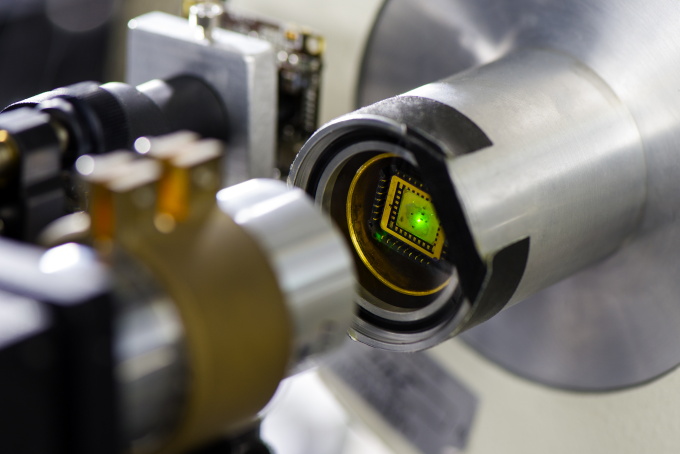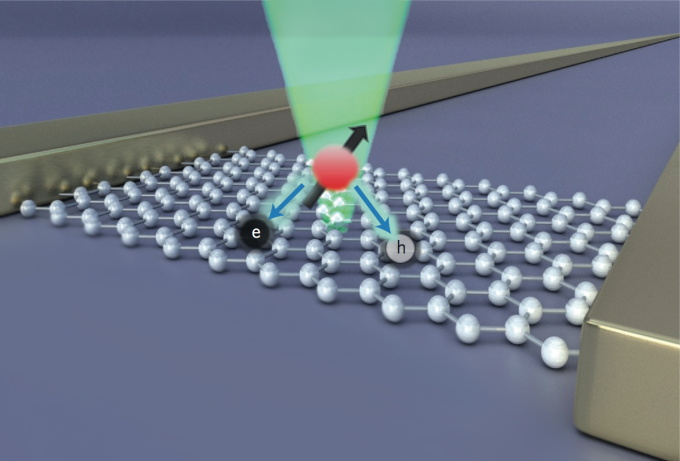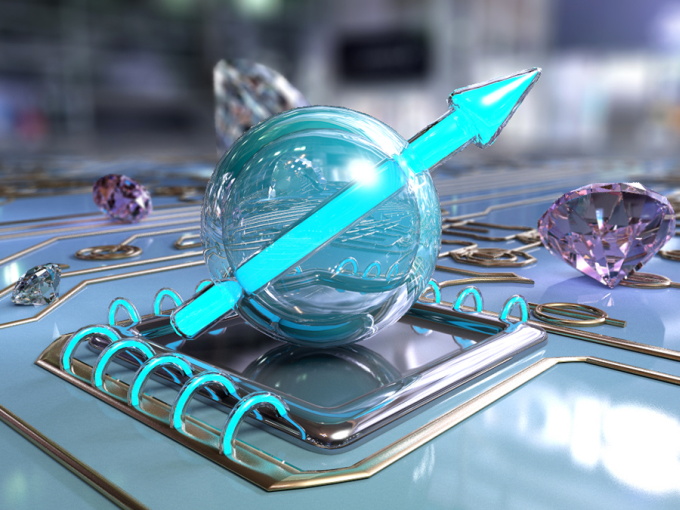Möglicher Lesekopf für Quantencomputer
Graphenschicht liest optische Information aus Nano-Diamanten elektronisch aus
2014-12-01 – Nachrichten aus dem Physik-Department
 Mess-Chip zum Auslesen der Information aus Stickstoff-Fehlstellen-Zentren in Nanodiamanten (Photo: Astrid Eckert / TUM)
Mess-Chip zum Auslesen der Information aus Stickstoff-Fehlstellen-Zentren in Nanodiamanten (Photo: Astrid Eckert / TUM)
Idealer Weise besteht ein Diamant aus reinem Kohlenstoff. Doch in der Natur sind immer auch kleine Verunreinigungen darin zu finden. Am besten untersucht sind Doppelfehlstellen, die aus einem Stickstoffatom und einer Leerstelle bestehen. Sie könnten als hochempfindliche Sensoren oder als Registerbausteine für Quantencomputer eingesetzt werden – doch bisher gab es keinen Weg, die optisch hinein gesteckte Information elektrisch wieder auszulesen.
Ein Team unter Leitung von Professor Alexander Holleitner, Physiker am Physik-Department und Frank Koppens, Physikprofessor am Institut de Ciencies Fotoniques nahe Barcelona, hat nun eine solche Auslesemöglichkeit geschaffen. Basis ist eine direkte Energieübertragung von Fehlstellen in Nanodiamanten auf eine unmittelbar benachbarte Graphenschicht.
 Zwischen zwei Goldelektroden liegt eine Graphenschicht, auf der Nanodiamanten mit Stickstoff-Fehlstellen-Zentren liegen. Dank der Graphenschicht kann man die optische Information aus den Nanodiamanten elektrisch auslesen. (Grafik: Christian Hohmann / Nanosystems Initiative Munich (NIM))
Zwischen zwei Goldelektroden liegt eine Graphenschicht, auf der Nanodiamanten mit Stickstoff-Fehlstellen-Zentren liegen. Dank der Graphenschicht kann man die optische Information aus den Nanodiamanten elektrisch auslesen. (Grafik: Christian Hohmann / Nanosystems Initiative Munich (NIM))
Strahlungsloser Energietransfer
Bestrahlt man einen solchen Nanodiamanten mit Laserlicht, so hebt ein Licht-Photon im Stickstoff-Fehlstellen-Zentrum ein Elektron von seinem Normalzustand in einen angeregten Zustand. „Das System aus dem angeregten Elektron und dem verlassenen Grundzustand kann man als Dipol auffassen“, sagt Professor Alexander Holleitner. „Dieser Dipol erzeugt in der nahegelegenen Graphenschicht wieder einen Dipol aus einem Elektron und einer Leerstelle“.
Doch während in den rund 100 Nanometer großen Diamanten die einzelnen Fehlstellen-Zentren voneinander isoliert sind, ist die Graphenschicht elektrisch leitend. Zwei Goldelektroden erfassen die erzeugte Ladung und machen sie elektronisch messbar.
 Künstlerische Vision eines zukünftigen Quantencomputers mit Nanodiamanten als Quantenregister und Graphen-Ausleseeinheit (Grafik: Christoph Hohmann / Nanosystems Initiative Munich (NIM))
Künstlerische Vision eines zukünftigen Quantencomputers mit Nanodiamanten als Quantenregister und Graphen-Ausleseeinheit (Grafik: Christoph Hohmann / Nanosystems Initiative Munich (NIM))
Elektronische Detektion im Pikosekundenbereich
Wesentlich für diesen Versuchsaufbau ist, dass die Messung extrem schnell geschieht. Denn nach wenigen Milliardstel Sekunden würde sonst das erzeugte Elektron-Loch-Paar wieder verschwinden. Doch die in Holleitners Labor entwickelte Technik erlaubt Messungen im Pikosekundenbereich (Billionstel Sekunden). Damit können die Wissenschaftler die Vorgänge genau verfolgen.
„Prinzipiell müsste unsere Technik auch mit Farbstoffmolekülen funktionieren“, sagt Doktorand Andreas Brenneis, der zusammen mit Louis Gaudreau die Messungen durchgeführt hat. „Ein Diamant enthält rund 500 solcher Fehlstellen, aber die Methode ist so empfindlich, dass wir auch einzelne Farbstoffmoleküle messen könnten“.
Aufgrund der extrem schnellen Schaltgeschwindigkeit der von den Wissenschaftlern entwickelten Nanoschaltkreise könnten mit dieser Technik aufgebaute Sensoren nicht nur extrem schnelle Vorgänge messen sondern würden, eingebaut in einem zukünftigen Quantencomputer auch extrem hohe Taktraten bis in den Terahertz-Bereich ermöglichen.
Die Arbeit wurde unterstützt aus Mitteln der Deutschen Forschungsgemeinschaft (Exzellenzcluster Nanosystems Initiative Munich, NIM und SFB 631), des European Research Councils (ERC Grant NanoREAL, CarbonLight), der Fundacio Cellex Barcelona, des Marie-Curie International Fellowship COFUND sowie des ICFOnest Programms und des Center for NanoScience (CeNS) München. An der Publikation wirkten Physiker der TU München, der Universität Augsburg, des Walther-Meißner-Instituts der Bayerischen Akademie der Wissenschaften und des ICFO-Institut de Ciencies Fotoniques in Castelldefels nahe Barcelona mit.
Publikation
Ultrafast electronic readout of diamond nitrogen-vacancy centres coupled to graphene, Andreas Brenneis, Louis Gaudreau, Max Seifert, Helmut Karl, Martin S. Brandt, Hans Huebl, Jose A. Garrido, Frank H. L. Koppens and Alexander W. Holleitner Nature Nanotechnology, Advanced online publication, 1. Dezember 2014 – DOI:10.1038/nnano.2014.276
Kontakt
Prof. Dr. Alexander W. Holleitner
Walter Schottky Institut – Zentrum für Nanotechnologie und Nanomaterialien